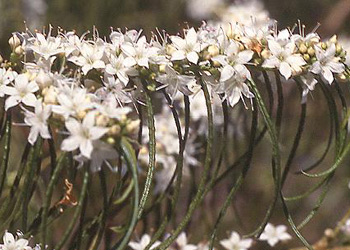
Striking Beauties
Leigh Murray
Two beautiful shrubs strike so readily that they form roots in water: Prostanthera incisa and Myoporum floribundum. I put cuttings into water in brown glass bottles, keep them on the kitchen sill until roots form, and then pot them up carefully.
Prostanthera incisa
Prostanthera incisa forms a neat 1 metre x 1 metre shrub with masses of lilac flowers for a short period in spring. It's ideal beside pathways because its dense foliage is soft and can be pruned to suit, and has a wonderful minty aroma when brushed past. P.incisa grows well at both Queanbeyan, where we have 20-year-old plants (they were called P.sieberi back then), and Tuross Head in slightly sheltered positions.
We tried several P.incisa 'Rosea' at Queanbeyan years ago, but they weren't as hardy as the plain vanilla form. We grow all of our P.incisa in partly shaded spots.
Myoporum floribundum
 |
|
Myoporum floribundum
Photo: Brian Walters
|
|
Myoporum floribundum stops us in our tracks when it is in full glorious bloom in summer. Tiny white flowers dust the tops of the weeping branches with what looks like snow. Usually there are clouds of small insects in at- tendance. Our shrubs reach about 2 metres x 2 metres with a graceful, open habit. M.floribundum survives drought and frost on our rocky Queanbeyan ridge, although it might look even more handsome in moister soil.
We lost our biggest one at Tuross during the drought, probably from dryness but possibly from a dislike of salty winds or pruning. I'm still trying there, with slightly better watering - so far so good. Our M.floribundum are usually grown in open, sunny positions.
Two months ago I planted a close relative, M.bateae, on the eastern side of the house at Queanbeyan. This is the best spot available at our place for a plant said to like a moist subsoil and shade. At this stage, it looks similar to M.floribundum except that its flowers are pale pink.
* * * * * *
Two other shrubs that are beautiful and strike easily (but not in water) are Melaleuca fulgens and Crowea 'Poorinda Ecstasy'. Even I have had striking success with these little beauties.
Melaleuca fulgens
Melaleuca fulgens 'Hot Pink' form is one of our favourite shrubs at Tuross. Planted in a sunny rock pocket near granite boulders, it's been delighting us for months with its brilliant hot pink flowers, sometimes just a few, sometimes many, always a joy. The flowers, tipped with gold, are stunners when seen close up (they're almost - but not quite - as gorgeous as those on the nearby Eucalyptus caesia ssp. magna 'Silver Princess'). The main flowering season of M.fulgens is spring/summer, but our plant started flowering again in autumn and just kept on going into winter. I tip prune it fairly frequently to encourage bushiness, and perhaps this is increasing the flowering as well. Adequate moisture might also be helping. Whilst it's not a top-class bird plant (that is, it's not a focus of bird activity, as are plants such as Eucalyptus leucoxylon and Grevillea arenaria), its flowers are proving surprisingly popular. Red and Little Wattlebirds make frequent visits, as do Rainbow Lorikeets (whose orange patches clash something awful with the hot pink flowers!).
Our M.fulgens is still a young bush, maybe a metre high. We're so keen on it that I recently planted two more at Tuross and one at Queanbeyan in a less frosty area (it's marginal for frost tolerance when young - ours came through winter bedraggled but alive).
Crowea 'Poorinda Ecstasy'
 |
|
Crowea 'Poorinda Ecstasy'
Photo: Brian Walters |
|
Crowea 'Poorinda Ecstasy' looks delicate but it's really pretty tough. It has proved tougher in our conditions at Queanbeyan than either of its parents (it's a hybrid of C.saligna and C.exalata).
We've been growing it for nearly 20 years, and some of our original plants are still with us, and still looking good. A few years ago, I planted six Crowea 'Poorinda Ecstasy' in a mixed planting on the shadier side of our driveway. Like their older namesakes, these plants came through the drought well, and they're proving ideal in this position. They form small (less than a metre) rounded shrubs with soft foliage and soft stems that won't attack cars or people. They take pruning well, so they can be trimmed back if necessary (tip pruning is usually all they get at our place). Best of all, they flower for much of the year with bright pink star flowers that are well displayed above the light green foliage. We love these shrubs. They look so cheery they lift our spirits on a dull day.
From 'Native Plants for New South Wales', newsletter of the Australian Plants Society (NSW), January 2006.
Australian Plants online - 2009
Australian Native Plants Society (Australia)
|